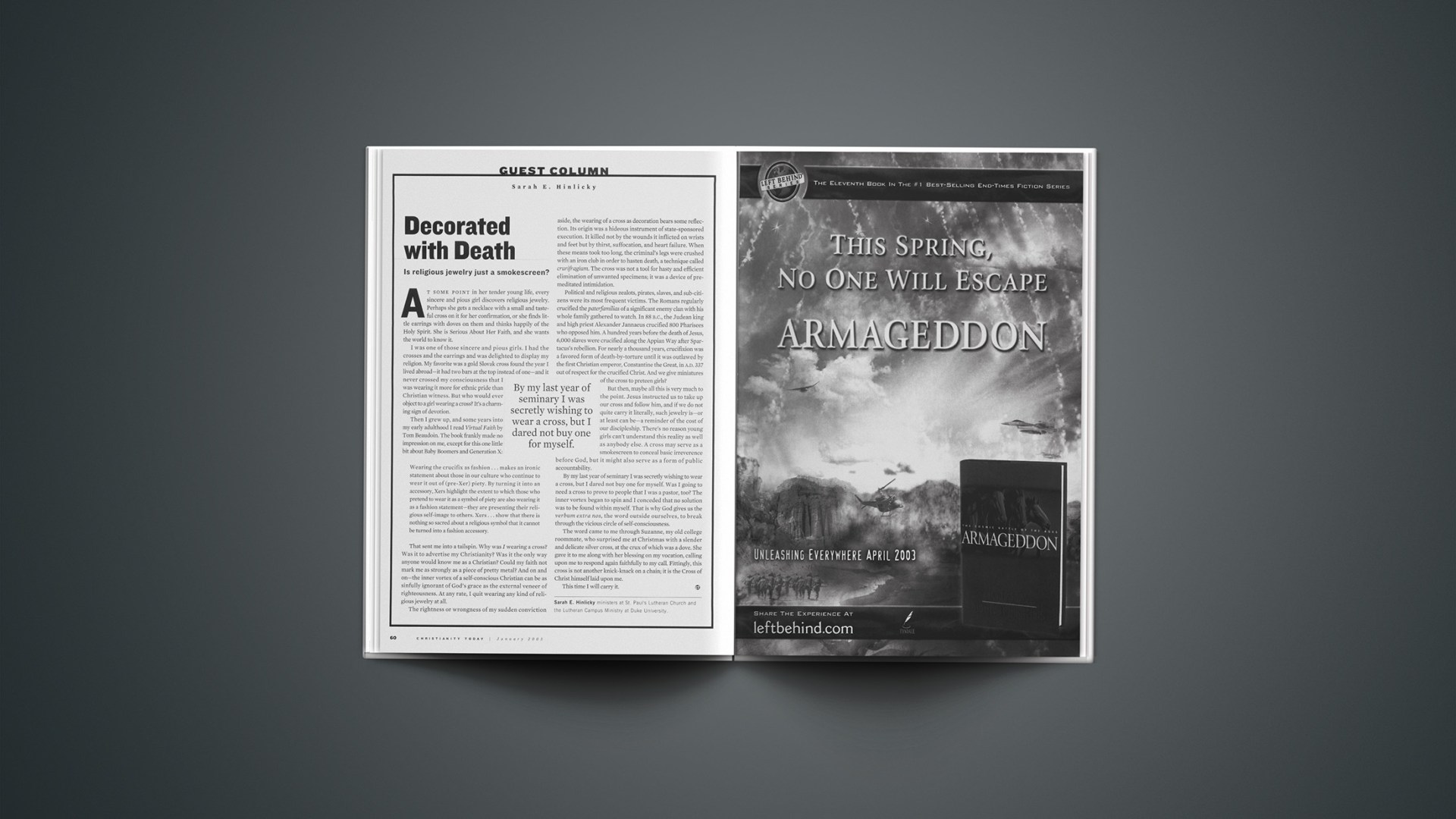At some point in her tender young life, every sincere and pious girl discovers religious jewelry. Perhaps she gets a necklace with a small and tasteful cross on it for her confirmation, or she finds little earrings with doves on them and thinks happily of the Holy Spirit. She is Serious About Her Faith, and she wants the world to know it.
I was one of those sincere and pious girls. I had the crosses and the earrings and was delighted to display my religion. My favorite was a gold Slovak cross found the year I lived abroad—it had two bars at the top instead of one—and it never crossed my consciousness that I was wearing it more for ethnic pride than Christian witness. But who would ever object to a girl wearing a cross? It’s a charming sign of devotion.
Then I grew up, and some years into my early adulthood I read Virtual Faith by Tom Beaudoin. The book frankly made no impression on me, except for this one little bit about Baby Boomers and Generation X:
Wearing the crucifix as fashion … makes an ironic statement about those in our culture who continue to wear it out of (pre-Xer) piety. By turning it into an accessory, Xers highlight the extent to which those who pretend to wear it as a symbol of piety are also wearing it as a fashion statement—they are presenting their religious self-image to others. Xers … show that there is nothing so sacred about a religious symbol that it cannot be turned into a fashion accessory.
That sent me into a tailspin. Why was I wearing a cross? Was it to advertise my Christianity? Was it the only way anyone would know me as a Christian? Could my faith not mark me as strongly as a piece of pretty metal? And on and on—the inner vortex of a self-conscious Christian can be as sinfully ignorant of God’s grace as the external veneer of righteousness. At any rate, I quit wearing any kind of religious jewelry at all.
The rightness or wrongness of my sudden conviction aside, the wearing of a cross as decoration bears some reflection. Its origin was a hideous instrument of state-sponsored execution. It killed not by the wounds it inflicted on wrists and feet but by thirst, suffocation, and heart failure. When these means took too long, the criminal’s legs were crushed with an iron club in order to hasten death, a technique called crurifragium. The cross was not a tool for hasty and efficient elimination of unwanted specimens; it was a device of premeditated intimidation.
Political and religious zealots, pirates, slaves, and sub-citizens were its most frequent victims. The Romans regularly crucified the paterfamilias of a significant enemy clan with his whole family gathered to watch. In 88 B.C., the Judean king and high priest Alexander Jannaeus crucified 800 Pharisees who opposed him. A hundred years before the death of Jesus, 6,000 slaves were crucified along the Appian Way after Spartacus’s rebellion. For nearly a thousand years, crucifixion was a favored form of death-by-torture until it was outlawed by the first Christian emperor, Constantine the Great, in A.D. 337 out of respect for the crucified Christ. And we give miniatures of the cross to preteen girls?
But then, maybe all this is very much to the point. Jesus instructed us to take up our cross and follow him, and if we do not quite carry it literally, such jewelry is—or at least can be—a reminder of the cost of our discipleship. There’s no reason young girls can’t understand this reality as well as anybody else. A cross may serve as a smokescreen to conceal basic irreverence before God, but it might also serve as a form of public accountability.
By my last year of seminary I was secretly wishing to wear a cross, but I dared not buy one for myself. Was I going to need a cross to prove to people that I was a pastor, too? The inner vortex began to spin and I conceded that no solution was to be found within myself. That is why God gives us the verbum extra nos, the word outside ourselves, to break through the vicious circle of self-consciousness.
The word came to me through Suzanne, my old college roommate, who surprised me at Christmas with a slender and delicate silver cross, at the crux of which was a dove. She gave it to me along with her blessing on my vocation, calling upon me to respond again faithfully to my call. Fittingly, this cross is not another knick-knack on a chain; it is the Cross of Christ himself laid upon me.
This time I will carry it.
Sarah E. Hinlicky ministers at St. Paul’s Lutheran Church and the Lutheran Campus Ministry at Duke University.
Copyright © 2003 Christianity Today. Click for reprint information.
Related Elsewhere
Hinlicky’s previous articles for Christianity Today and Books & Culture include:
Reuniting Mary and Martha | Theology is women’s work, too. (CT, Nov. 1, 2001)
The Great Reunion Beyond | Death is the heartless divider—or so I thought before I watched my grandpa die. (CT, Feb. 15, 2001)
Free to Be Creatures Again | How predestination descended like a dove on two unsuspecting seminarians, and why they are so grateful. (CT, Oct. 17, 2000)
Urbane Bigotry | A review of Chloe Breyer’s The Close: A Young Woman’s First Year At A Seminary (B&C, Sep/Oct 2000)
SWF Seeks Marriage Partner | I’ve got it all. So why do I want a husband? (B&C, Jul/Aug 2000)
An Open-Door Policy | Is meeting alone with a member of the opposite sex dangerous? Is taking steps against it sexist? (CT, Nov. 11-16, 1999)
Hinlicky is also a regular contributor to First Things, where she wrote “Talking to Generation X,” “Subversive Virginity,” and “Don’t Write About Race,” and to re:generation quarterly, where she has written about Mary.










